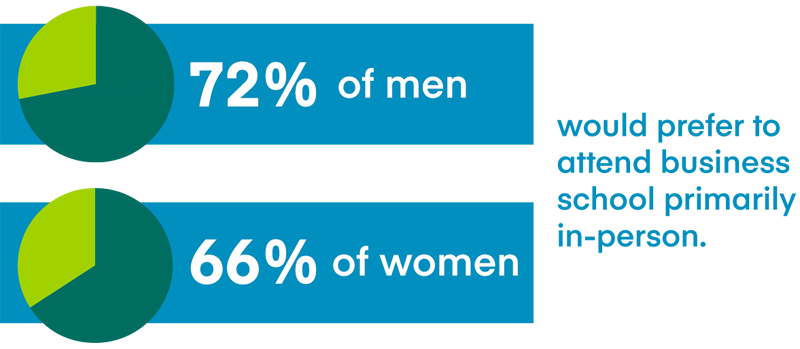Are Attitudes Changing Toward Online Learning?
- During the pandemic, more business schools offered and more business students sought out online learning options.
- More students and employers today view online learning as comparable in quality to in-person education.
- However, students still give the edge to on-campus learning because they value the chance to network with faculty and peers.
The pandemic has reshaped our society in a multitude of ways. But perhaps the most notable way it has impacted higher education is that it sparked the rapid and comprehensive adoption of online education. Online learning is no longer considered a peripheral option best suited for working professionals too busy to sit in physical classrooms. Rather, more than two years into the pandemic, most students now expect to choose in-person or online delivery for most of their courses—or even for different sessions within the same course—depending on their schedules and preferences.
AACSB and two other organizations have gathered data that offer a glimpse into where student attitudes about online learning might be headed. AACSB has tracked growth in enrollments in online programs, as well as in online program delivery. In two recent surveys, the Graduate Management Admission Council, an association of graduate business schools and owner of the Graduate Management Admission Test, asked students how they value online education. In addition, Studyportals, a platform where prospective students can explore online education options worldwide, has analyzed its website traffic to gauge how interest in online learning opportunities has been affected by the pandemic.
The numbers highlighted below suggest that students still value—and most often prioritize—the learning and networking advantages of in-person education. That said, depending on factors such as gender and type of program involved, learners and employers increasingly view online education as an equivalent and viable option for training.
Students Flock to Online Master’s Programs
According to the trends noted by AACSB researchers, many people likely reevaluated their career trajectories after the world went into lockdown in 2020. After COVID struck, the association gathered data that showed a substantial increase in the number of students who enrolled in online master’s programs in 2020–21. Before COVID emerged during the 2019–20 academic year, AACSB had actually measured a slowdown in growth for online master’s enrollments. However, enrollments in online programs grew dramatically, by 158 percent, for the 2020-21 academic year:

AACSB also measured growth in the number of programs offered fully online across every educational level it tracks:
| NUMBER OF FULLY ONLINE PROGRAMS | |||||
|---|---|---|---|---|---|
| Education Level | 2016–17 | 2017–18 | 2018–19 | 2019–20 | 2020–21 |
| Doctoral | 3 | 4 | 5 | 7 | 47 |
| Integrated Undergraduate Master's | 2 | 2 | 4 | 1 | 3 |
| Master's Generalist (EMBA) | 9 | 9 | 9 | 7 | 28 |
| Master's Generalist (MBA) | 313 | 361 | 468 | 561 | 682 |
| Master's Generalist (MBA/Dual Degree) | 3 | 6 | 9 | 10 | 24 |
| Master's Generalist (non-MBA) | 1 | 3 | 3 | 11 | 26 |
| Master's Specialist | 182 | 198 | 251 | 305 | 556 |
| Undergraduate | 203 | 224 | 322 | 366 | 701 |
| Undergraduate Certificate | 8 | 12 | 30 | 41 | 50 |
| Total | 724 | 819 | 1,101 | 1,309 | 2,117 |
At the 526 AACSB-member schools that reported data in each of the last five years, master’s-level programs saw less dramatic spikes in 2020–21 than doctoral and undergraduate. The reason is likely because business schools already had been delivering many of their master’s programs online, at least in part.
However, the number of undergraduate programs offered fully online nearly doubled; similarly, the doctoral programs offered by the reporting schools—which historically have rarely offered their doctoral programs fully online—increased nearly sevenfold, from just 7 to 47.
The association will keep tracking these trends to see whether growth in online enrollments and program delivery continues or begins to pull back again once the pandemic abates.
Increased Interest at All Levels
If traffic on Studyportals’ website is an indication, more prospective students are considering online options. According to the company’s recent analysis:
- During the pandemic, there was a 9.6 percent increase in page views on its website.
- This increase was driven largely by student interest in European programs—particularly those in the United Kingdom, Switzerland, Germany, and Spain.
- Page views also were up among prospective students in emerging markets such as India, Pakistan, Vietnam, Brazil, Malaysia, Thailand, and Indonesia.
- The percentage of visitors exploring programs related to business and management remained unchanged at just over 25 percent.
There also was an increase in the number of online programs in business and management listed on the website, particularly in the U.S. and U.K, the two countries that offer the greatest number of programs in these disciplines. Between January 2018 and October 2021, the company recorded the following changes in the listings on its platform:
- The number of listings for U.S.-based online programs in business and management increased from around 1,500 to 2,500.
- The number of listings for U.K.-based online programs in these disciplines increased from 705 to 1,000.
- Listings of online programs in business and management also increased in Ireland, Switzerland, Spain, and Germany.
The number of listings grew across bachelor’s programs, master’s programs, and short courses. This upward trend, say company representatives, indicates that providers are responding to increased demand for alternative education options by designing new online learning opportunities, especially for fields in demand.
The business and management programs attracting the most page views on the website have been those in the fields of marketing and digital marketing. Conversely, business disciplines attracting fewer page views year on year include project management, entrepreneurship, and strategy.
The Perceived Value of Online Education
Data from two GMAC surveys reveal that a significant portion of employers and prospective students place online education on a par with in-person learning opportunities. For example, GMAC’s 2021 Corporate Recruiters Survey asked recruiters about their level of agreement to several statements regarding the role online programs played in their organizations’ training strategies. More than a third of respondents indicated that their employers now viewed virtual and face-to-face learning as equally effective:
My organization values graduates of online and in-person programs equally.
| ALL RESPONDENTS | ||
|---|---|---|
| Strongly disagree | 8% | |
| Disagree | 29% | |
| Neither agree nor disagree | 29% | |
| Agree | 24% | |
| Strongly agree | 10% | |
(N = 569)
Across industries, recruiters in finance and accounting were most likely to say they agreed or strongly agreed that their organizations viewed online and face-to-face learning equally, at 41 percent. Those in consulting were least likely to say the same, at only 25 percent.
Surprisingly, organizations in the tech industry fell in the lower end of this group, with 28 percent agreeing or strongly agreeing that online and virtual education offered equal benefit.
When broken down by region, only 29 percent of recruiters in Asia agreed or strongly agreed that their organizations valued online and on-campus programs equally. Among those in the U.S., 32 percent agreed with the above statement, while 39 percent disagreed or strongly disagreed. In Europe, 40 percent of recruiters agreed that their organizations valued both modes of delivery equally; in the rest of the world (excluding the U.S. and Asia), that number was 47 percent.

Students Still Prefer Face-to-Face
Prospective students seem to have a less favorable view than employers of online graduate business education. Among more than 2,000 people who responded to GMAC’s mba.com Prospective Students Survey between January 2021 and June 2021, only 14 percent agreed or strongly agreed with the following statement:
I believe that on-campus and online graduate business education experiences offer the same value.
| ALL RESPONDENTS | ||
|---|---|---|
| Strongly disagree | 27% | |
| Disagree | 47% | |
| Neither agree nor disagree | 12% | |
| Agree | 11% | |
| Strongly agree | 3% | |
(N = 2,589)
| BY GENDER* | ||
|---|---|---|
| Male | Female | |
| Strongly disagree | 30% | 21% |
| Disagree | 45% | 51% |
| Neither agree nor disagree | 11% | 13% |
| Agree | 10% | 13% |
| Strongly agree | 3% | 2% |
| BY PROGRAM PREFERENCE/PREFERRED STUDY DESTINATION* | |||||||
|---|---|---|---|---|---|---|---|
| MBA–Domestic | MBA–International | Business Master’s–Domestic | Business Master’s–International | Other Business Degree–Domestic | Other Business Degree–International | ||
| Strongly disagree | 25% | 33% | 14% | 29% | N/A | 25% | |
| Disagree | 45% | 49% | 49% | 49% | N/A | 55% | |
| Neither agree nor disagree | 14% | 8% | 15% | 11% | N/A | 10% | |
| Agree | 12% | 8% | 18% | 8% | N/A | 10% | |
| Strongly agree | 3% | 2% | 4% | 3% | N/A | 0% | |
Even fewer respondents agreed with the following statement:
Networking opportunities gained through an on-campus graduate business degree are the same as those gained through an online degree.
| ALL RESPONDENTS | |
|---|---|
| Strongly disagree | 37% |
| Somewhat disagree | 44% |
| Neither agree nor disagree | 10% |
| Somewhat agree | 6% |
| Strongly agree | 3% |
When asked the same question related to career opportunities, 65 percent of prospective students disagreed or strongly disagreed that on-campus experiences provided the same benefits as those delivered online.
Reputation Makes a Difference
Student attitudes shifted, however, once they were asked to take the reputation and selectivity of institutions into account. Forty percent agreed or strongly agreed with the following statement:
I would choose to pursue a graduate business degree online at a higher-ranked school than an on-campus degree from a lower-ranked school.
| ALL RESPONDENTS | |
|---|---|
| Strongly disagree | 11% |
| Disagree | 26% |
| Neither agree nor disagree | 22% |
| Agree | 28% |
| Strongly agree | 12% |
Prospective students interested in MBA or business master’s programs in their home countries were most likely to agree or strongly agree with the statement (47 percent and 48 percent, respectively). Those least likely to agree or strongly agree were those interested in pursuing MBAs or business master’s programs internationally (35 percent and 36 percent, respectively).

The COVID Effect
Finally, 2,360 prospective students answered a question related to how COVID-19 has affected their willingness to consider online business and management course delivery. On the one hand, their preferred form of course delivery is still, by far, in-person learning, given their responses to the following question:What is your preferred program delivery?
- Primarily in-person: 70 percent
- Primarily online: 6 percent
- Hybrid: 20 percent
- Undecided: 4 percent
Among those responding to this question, more men (72 percent) than women (66 percent) said that they would prefer to attend business school primarily in-person. Likewise, more students interested in international MBA programs (81 percent) than students interested in domestic MBA programs (55 percent) expressed preferences for in-person education.

On the other hand, the numbers shifted when students were asked how COVID-19 affected their attitudes. Twenty-one percent of 2,319 students responding said that they were “more willing to consider online learning” as a result of the pandemic. A significant portion said they would be willing to take one third or more of their courses online, in answer to the following question:
If you were accepted into a graduate business program, what percent of your program would you be willing to complete online as a result of COVID-19?
- Less than 10 percent: 18 percent
- 10 percent to 30 percent: 41 percent
- More than 30 percent: 41 percent
GMAC’s survey also asked students to indicate why they would not consider completing any portion of their business and management education online. The chance to network loomed large, with 91 percent of the 337 who responded noting that they would choose on-campus over online learning because they believed that online options offered “less interaction/networking with peers.”

They also were concerned about the quality of online education (69 percent), employer perceptions of online programs (60 percent), and the availability of internships (49 percent). Far fewer were concerned about the inability to attend live online courses (16 percent), a lack of internet services (12 percent), or a lack of employer-sourced funding for online education (7 percent).
Future Considerations
These initial data points paint an interesting picture of the post-pandemic higher education landscape. All in all, more students than ever are comfortable with engaging in online education, which could represent opportunities for institutions in positions to expand their online offerings.
That said, most of this year’s prospective students make clear that, when given the option, they still believe in-person programs provide the richest experiences and the best opportunities for networking with their peers. As learner preferences continue to evolve, enriching networking opportunities in virtual spaces might be one way for business schools to make their online offerings even more attractive to students in the years to come.






